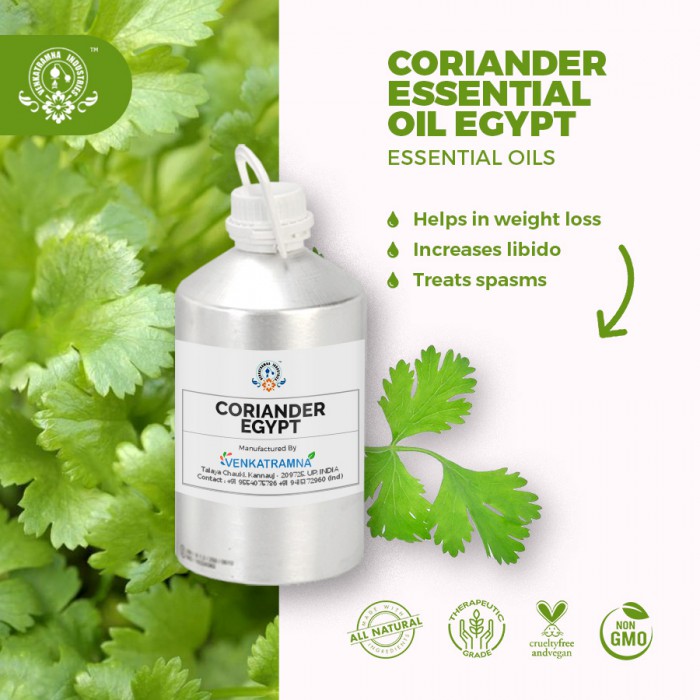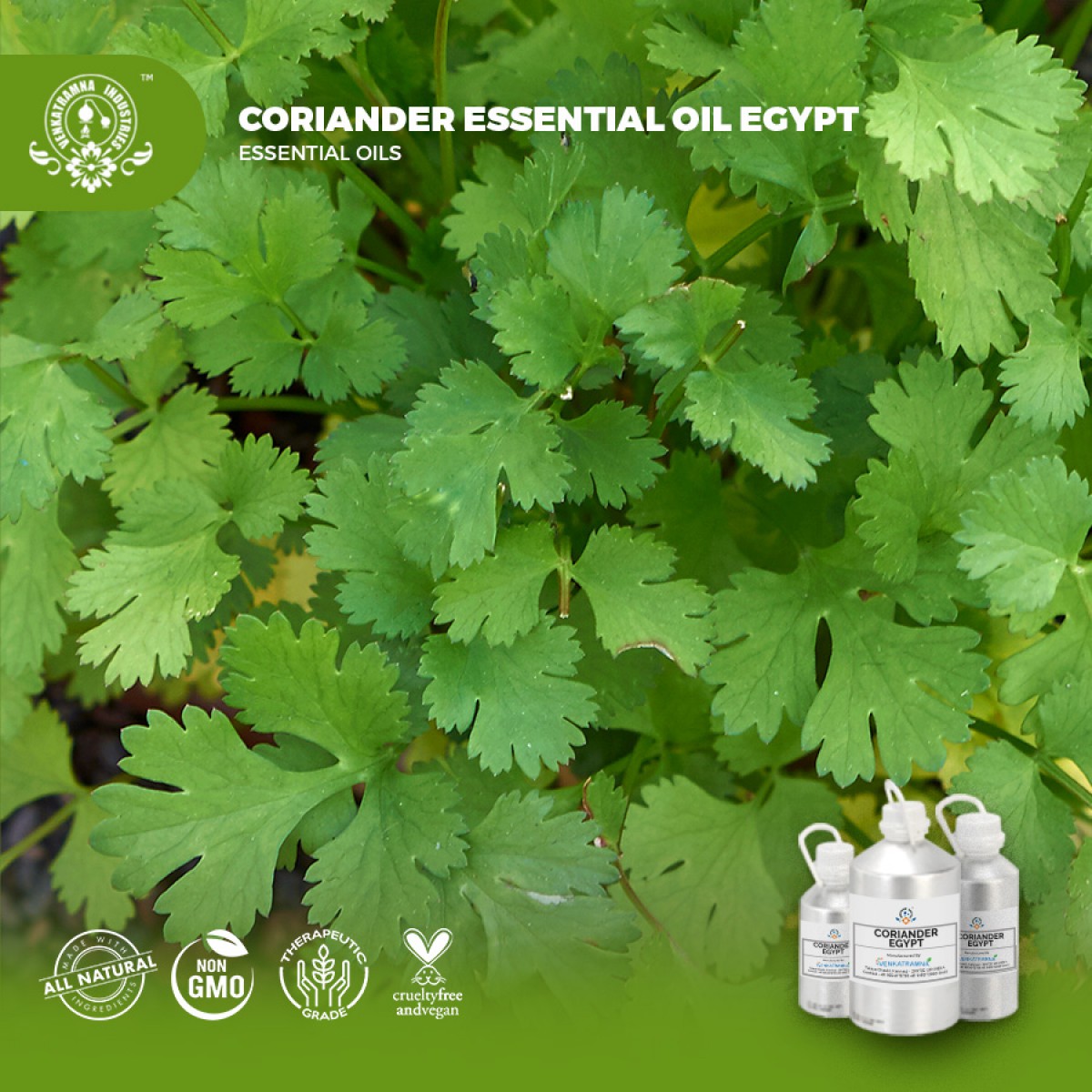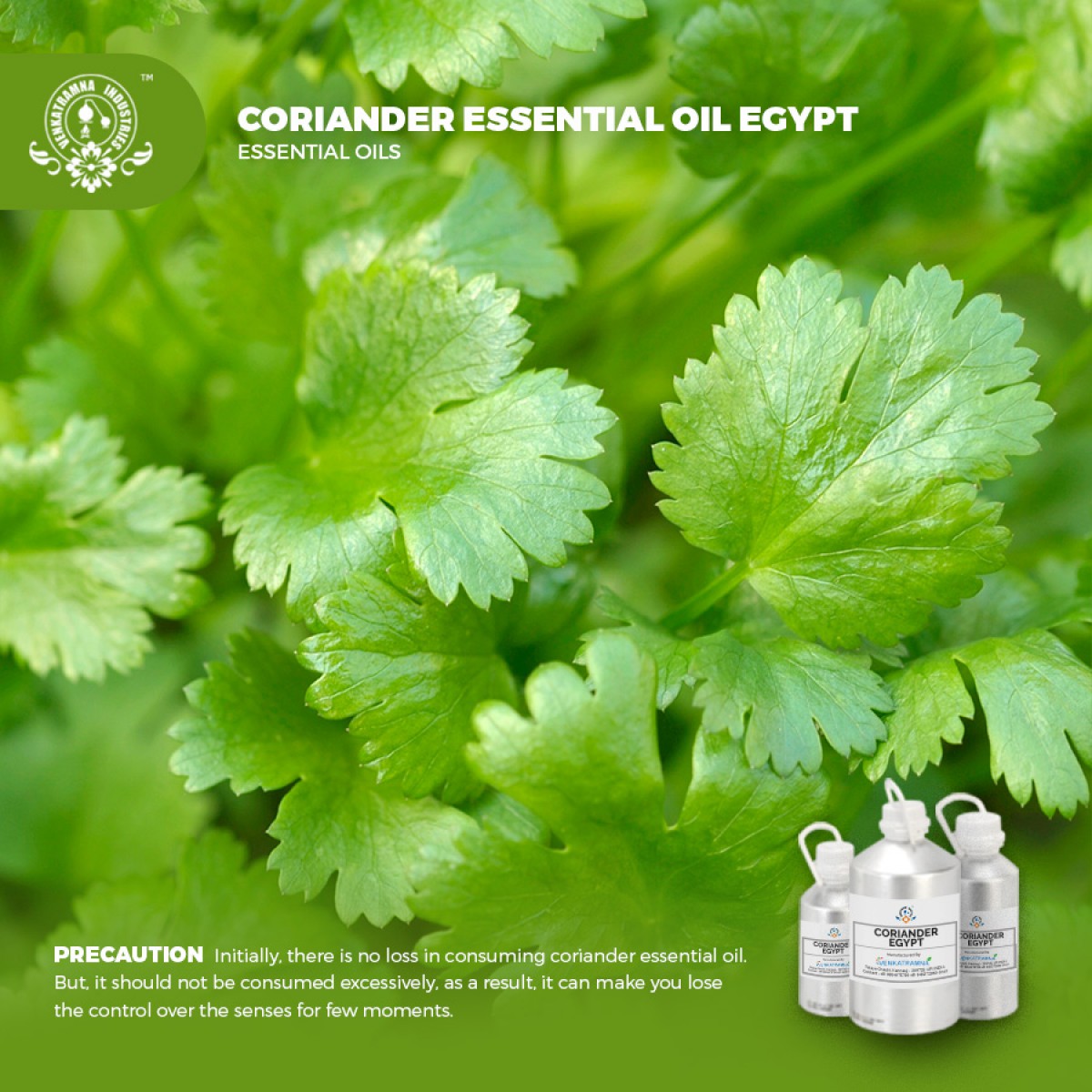Botanical Name: Coriandrum sativum L. Common name: Coriander, Kothumalli, Kothimbir Read More
|
Botanical Name: |
Coriandrum sativum
L. |
|
Common name: |
Coriander, Kothumalli, Kothimbir, Dhana, Malli, Dhania. |
|
Plant family: |
Apiaceae |
|
Genus: |
Coriandrum |
|
Appearance/Color: |
A thin, colorless to pale yellow liquid |
|
Odor: |
A slightly sweet, herbaceous and spicy smell |
|
Blends With: |
Cinnamon Bark, Bergamot, Ginger, Neroli, Grapefruit and
Orange |
|
Origin: |
Egypt |
Coriander (Coriandrum
sativum L.) is a plant from the family of Apiaceae. Seeds and the herb of
coriander, both of which are used as spice or a medicinal plant. It contains
flavoring compounds such as linalool, geraniol, pinen, limonene, geranylacetat,
terpinen, and borneol. It is broadly cultivated in various environments
around the globe. In general, coriander falls into two major categories based
on fruit size. This ultimately determines its oil content and use.
India is the biggest producer, consumer and exporter of coriander in the world with an annual production of around three lakh tonnes. It is an annual, herbaceous plant which originated from the Mediterranean and Middle Eastern regions and known as medicinal plants. It contains an essential oil (0.03 to 2.6%) (Nadeem et al., 2013). All parts of this herb are in use as flavoring agent and/or as traditional remedies for the treatment of different disorders in the folk medicine systems of different civilizations (Sahib et al., 2012). Coriander closely resembles flat leaf parsley. This resemblance makes many people confused between the two however, coriander has strong fragrance and parsley has mild fragrance. It grows best in dry climates however it can grow in any type of soil like light, well drained, moist, loamy soil, and light to heavy black soil (Verma et al., 2011). Its seeds are almost ovate, globular and have a mild, sweet, slight pungent like citrus flavor with a hint of sage. The most important constituents of its seeds are the essential oil and fatty oil.
DISCLAIMER
The complete range of conditions
or methods of use are beyond our control therefore we do not assume any
responsibility and expressly disclaim any liability for any use of this
product. Information contained herein is believed to be true and accurate however,
all statements or suggestions are made without warranty, expressed or implied,
regarding accuracy of the information, the hazards connected with the use of
the material or the results to be obtained from the use thereof. Compliance
with all applicable federal, state, and local laws and local regulations
remains the responsibility of the user.
The FDA has not evaluated the
statements on this website. No claims are made by Venkatramna Industries as to
the medicinal value of any products from vriaroma.com or by us. The information
presented here is for educating our customers about the traditional uses of
essential oils and is not intended to diagnose, treat, cure, or prevent any
disease. You are responsible for understanding the safe application of these products.
If you have any questions, please call or email us for further information.
As per NAHA guidelines, New Directions Aromatics
(NDA) does not recommend the ingestion of essential oils. It is imperative to
consult a medical practitioner before using Essential Oils for therapeutic
purposes. Pregnant and nursing women and those taking prescription drugs are
especially advised not to use this product without the medical advice of a
physician. The oil should always be stored in an area that is inaccessible to
children, especially those under the age of 7.
Coriander (Coriandrum sativum)
is a medicinal and aromatic plant, widely grown in several parts of the world.
The essential oil of coriander is obtained from fully ripe dried seeds or
leaves using steam distillation. The oil is a colorless or pale yellow liquid
with a characteristic linalool odor and mild sweet, warm, and aromatic flavor.
Coriander oil is rich in linalool, limonene, ?-pinene, camphene, geranyl
acetate, and linalyl acetate. Coriander oil is extensively used in the food
industry as a flavoring agent. The essential oil also contributes to the
storage stability of the food products providing protection against
food-spoiling microorganisms. The dietary uses of the coriander essential oil
are therefore helpful in maintaining good health.
Coriander Essential Oil in Pharma
Coriander nutrition is basically
due to its green leaves and dried fruits. Like all other green leafy
vegetables, its leaves are a rich source of vitamins, minerals and iron. Its
leaves contain high amount of vitamin A (?-carotene) and vitamin C. The green
herbs contain vitamin C upto 160 mg/100 g and vitamin A upto 12 mg/100 g
(Girenko, 1982). It is very low in saturated fat and cholesterol and a very
good source of thiamine, zinc and dietary fiber. Green coriander contains 84%
water. Besides nutritional benefits, it is well known for its health or
medicinal benefits as well as for additional benefits like it acts as
antimicrobial agent. The type of meat and temperature did not influence the
antimicrobial activity of the oil; indicating the potential of coriander oil to
serve as a natural antimicrobial compound against Campylobacter jejuni in food
(Rattanachaikunsopon and Phumkhachorn, 2010). The most important and well
characterized functional aspect involves antioxidant activity
Essence of Coriander Essential
Oil
Coriander oil has distinct
applications in kitchen to add flavors in recipes. The plant seeds, leaves and
roots are edible, although they have very distinct flavors and uses. The herb
has a light and fresh flavor. Coriander can be used as whole plant and can be
processed because of its perishable nature of leaves and to increase the
palatability of ripe fruits (seeds) before using it as flavoring agent in
different food preparations. Whole plant of coriander mainly fresh leaves and
ripe fruits are used for culinary purposes. Coriander leaves have different
taste than its seeds, with citrus overtones. It promotes digestion, gives
relaxation and on the top is used for skin purposes. Due to its unique taste
and smell, it possesses some medicinal properties as well. Further, the oil can
be consumed to produce healthy cholesterol in the body.
COMMON USAGE
·
Helps in weight loss
·
Increase libido
·
Reduces gas problems
·
Treats spasms
·
Works as deodorant
·
Purifies blood
·
Eliminates body pain
·
Promotes hormonal secretion
·
Prevents fungal infection
Ingredients:
|
S.No |
Key Constituents |
Strength (%) |
|
1 |
Decanal |
4.4-18.0 |
|
2 |
(E)-2-decenal |
26.8-46.5 |
|
3 |
linalool |
4.3-17.5 |
|
4 |
2-decen-1-ol |
<9.2 |
|
5 |
(E)-2-dodecenal |
2.7-10.3 |
|
6 |
(E)-2-tetradecenal |
5.8 |
|
7 |
(E)-2-undecenal |
1.4-5.6 |
|
8 |
Decanol |
1.3-4.3 |
|
9 |
Nonane |
0.2-3.6 |
|
10 |
Dodecanal |
1.0-1.7 |
|
11 |
Tridecanal |
0.1-2.0 |
TOXICOLOGICAL
INFORMATION
Safety Summary
·
Hazardous: No Data
·
Contraindications: Not Known
·
Photo-toxicity: Not photo-toxic
Organ Specific Effects
·
Neurotoxicity Agarwood Oil vapors are sedative
to mice
Systemic Effects
·
Acute Toxicity: Coriander seed oil acute oral
LD50 in rats >5 g/ kg; acute dermal LD50 in rabbits 4.13 g/kg.
·
Skin corrosion/irritation: May be irritating to
skin.
·
Serious eye damage/irritation: May be irritating
to eyes. Prompt rinsing and removal of the substance will avoid damage.
·
Respiratory sensitization: Not applicable under
normal use.
·
Germ cell mutagenicity: Not specified
·
Carcinogenicity: Not listed As Carcinogen
·
Reproductive toxicity: Not specified
·
STOT-single exposure: Not specified
·
STOT-related exposure: Not specified
ECOLOGICAL
INFORMATION
·
Ecotoxicity Aquatic hazard acute category 2,
Aquatic hazard chronic category 2.
·
Persistence & Biodegradability No additional
data available.
·
PBT Assessment Results No additional data
available
·
Persistence and degradability Biodegradation is
expected
·
Bio-accumulative potential Bioaccumulation is
unlikely
·
Mobility in soil Unknown
Do not discharge into the
environment, especially not into waterways, sewers and the environment.





 MSDS-Coriander.pdf
MSDS-Coriander.pdf




